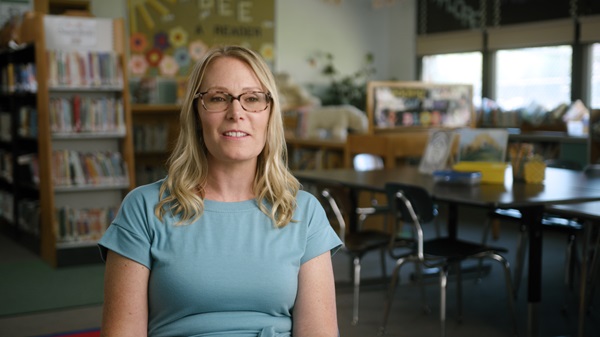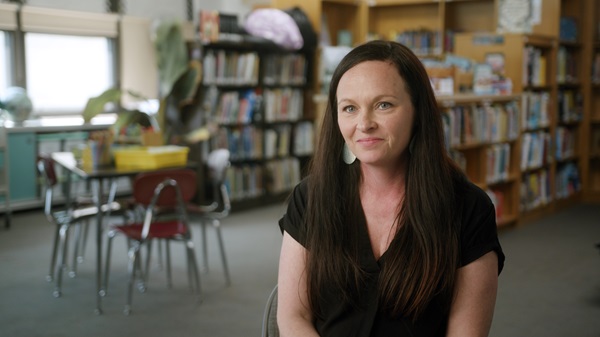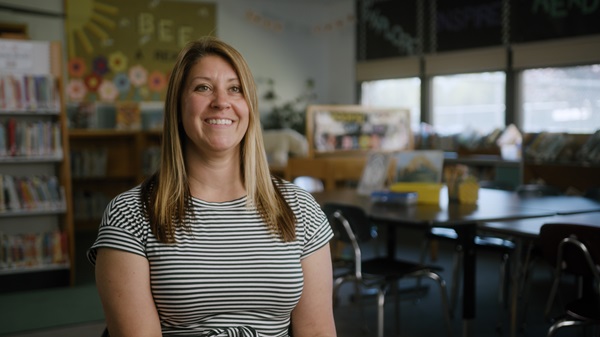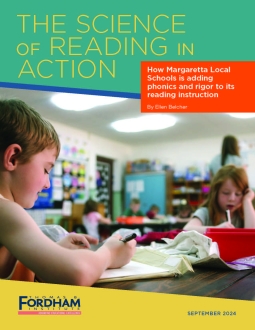Ohio elementary schools are moving to the Science of Reading, an approach that emphasizes phonics along with vocabulary- and knowledge-rich content. Keen on learning what this transition looks like inside classrooms, we asked Ellen Belcher, a former journalist with the Dayton Daily News, to visit Margaretta Local Schools to shine light on their literacy practices. Read below or download the report to learn more about Northridge's approach to reading curriculum and instruction.
Be sure also to check out this companion video to hear Margaretta Local Schools administrators and teachers talk about adopting curricula based on the Science of Reading:
When Ed Kurt came home to Margaretta Local School District in the summer of 2020, it was his second tour as superintendent. He had left the district six years earlier to lead Findlay City Schools.
But things were dramatically different. COVID-19 was raging. The district was providing hybrid instruction to reduce exposure to the virus. Classrooms were split, with groups of students alternating between in-person and online attendance. Teachers and children donned masks. Desks were wiped down between classes. Students were seated in pods separated by barriers.
Children across the country were rapidly falling behind because virtual classrooms were no substitute for in-person learning. Kurt particularly worried about students losing—or not learning—reading skills. When the federal government began distributing emergency pandemic funding to districts, he put most—more than 70 percent—of the $1.7 million Margaretta received over three school years into literacy curriculum and training.
“We think it was a four-year fix (to catch up from COVID),” Kurt said. “But we’re not cancer-free of literacy issues.”
(In 2022–23, the latest available data, 38 percent of Ohio third graders fell short of proficiency on the state reading test, as compared to 33 percent of Margaretta students.)
Situated in Castalia, a village along Lake Erie in northwestern Ohio, Margaretta has about 1,150 students, nearly a third of whom are identified as economically disadvantaged. With eighty teachers and support staff, its schools are the hub of a cluster of small communities in Erie and Sandusky counties, not far from Cedar Point amusement park.
Upon taking over, Kurt and his Curriculum Director Kevin Johnson insisted on adopting curricula based on the Science of Reading, which emphasizes teaching phonics and decoding skills. It was simply a best practice in their view, and one made more urgent by COVID learning losses.
Today, that focus is paying off. In 2023–24, 55 percent of kindergarten students began the year at or above grade level for the expected literacy skills of incoming kindergartners. At the end of the year, an impressive 80 percent were on grade level for skills children should have mastered by the end of the year. The first-grade class went from 36 percent to 56 percent testing at or above grade level. Scores in second grade fell slightly, from 63 percent reading on grade level at the beginning of the year to 61 percent in May, a dip that administrators attribute to the loss of two of four teachers mid-year.
Going all-in on the Science of Reading
When the district began to introduce Science of Reading practices, many Margaretta teachers, like their colleagues across Ohio, were unfamiliar with the teaching methods.
Calling Ohio a “Whole Language” state, Johnson said colleges and universities have trained generations of education majors to teach reading using that method. “Three-Cueing” and “Balanced Literacy” are similar approaches that are not evidence-based and that don’t give children sufficient instruction in phonics and phonemic awareness. Instead, these practices encourage students to look at pictures, guess words from context and memorize sight words, leaving them unable to decode new and increasingly difficult words.
In the first year of Kurt’s superintendency and amid the chaos of COVID, he and Johnson began conversations with teachers about the need to go all-in on instituting Science of Reading curricula. (It was not until July 2023, three years later, that Governor Mike DeWine signed legislation requiring that Ohio public schools teach students using the evidence-based approach and dedicating $168 million to the effort.)
The following summer, before the start of the 2021–22 school year, fifty-six staff members from the elementary, middle and high schools were paid to take thirty hours of Orton-Gillingham training. In addition, a dedicated literacy team of respected staff members was created. Orton-Gillingham Academy representatives also were brought in, while the University of Findlay, nearby educational service centers and an Ohio Department of Education and Workforce Support Team provided professional development in the Science of Reading.
Then, in 2022–23, the district received a $200,000 grant from the state to advance its literacy work. More training followed. The elementary school also began implementing “flooding,” a practice in which intervention specialists, aides, and student teachers descend on classrooms to work with students individually or in small groups to address reading deficits.
This past school year, the district rounded out its Science of Reading-based curricula, adopting Wit and Wisdom in grades K–5. That program is designed to improve vocabulary and comprehension, two of the five pillars of the Science of Reading that the district concluded it wasn’t sufficiently addressing. (The other pillars are phonemic awareness, phonics, and fluency, which the Orton-Gillingham method focuses on.)
While a “culture of literacy” took hold fairly quickly at the elementary level, buy-in was not as strong initially in the upper grades, said Heather Campana, a literacy coach. “I think that’s natural. They (middle school and high school teachers) are content-driven. They think, ‘I’m a mathematician.’ ‘I’m a scientist.’ … (But) as the students grow in their knowledge of science and math, for example, the words get longer and longer. So we need to know and understand, as teachers, how to support students in decoding multisyllabic words.”

Literacy Coach
Alyssa Fitz, a middle school intervention specialist, said helping older students improve their decoding skills increases their reading fluency. “If they’re spending so much time decoding words, they’re not going to get the comprehension,” she said.
Tranette Novak, a speech and language pathologist, said, “We have to get it right (at the elementary level). … If you don’t close that gap, it gets bigger. What we can do in a half hour (of intervention) takes two hours at the older grades. Where are you going to find those hours (in a middle or high school day)?”
Three years into instituting Science of Reading curricula and practices system-wide, Kurt said, “Change is really hard,” acknowledging that not everyone has been supportive of the move. “We have had some people leave,” he said.
New rigor isn’t too much for students
Kristy Jensen, a third-grade teacher and eighteen-year teaching veteran, said she is sold on Wit and Wisdom, the new, highly scripted K–5 curriculum that focuses on building vocabulary and increasing comprehension. It requires teachers to spend ninety minutes each day delving into topics like ocean life and the solar system, with children learning vocabulary that is typically two years above grade level.

Third grade teacher
“The best thing I’m seeing is their interest level,” Jensen said. Though she initially was concerned about the complexity of the text, she said, “They’re looking up facts on the weekend and coming in and telling me about what they found. They were enthralled about giant squids.”
At parent-teacher conferences this past school year, Jensen for the first time encountered families who said their child’s favorite subject is reading.
Shannon Bramel, a kindergarten teacher, agrees that Wit and Wisdom is rigorous and fosters high-level thinking. She said the books in the new curricula are rich in knowledge about topics many students haven’t been exposed to, recalling, for example, a story about the Galápagos Islands. After hearing her read aloud to them, students are encouraged to ask themselves, What do you wonder? What did you notice? “They have to think about what they’re listening to and come up with their own thoughts,” Bramel said.

Kindergarten teacher
Megan Olds, a first-grade teacher, echoed Jensen’s enthusiasm for Wit and Wisdom and Geodes, a supplemental curriculum to Wit and Wisdom. Referring to Geodes, she said, “To have these decodable books that are working on a skill, it’s life-changing. The kids love them. They also are teaching critical thinking skills. I have students saying, ‘The essential question is. …’”
Beyond Wit and Wisdom’s ninety minutes of reading instruction, K–3 teachers spend forty minutes on phonics each afternoon, followed by forty minutes of intervention, during which students are grouped according to their skill level.
One day in May, Bramel was teaching her kindergarten students about how to determine whether a word ends in “ck” or “k” and about “sneaky e’s” on the end of words. “The ‘e’ helps make the word’s long vowel sound,” Bramel explained, moving quickly through examples like “bake” and “shine” while students recited examples with her.
One challenge Bramel and her fellow teachers have encountered is that state-approved Science of Reading curricula does not always align with the state standards they’re supposed to teach, resulting in students not being introduced to specific skills or knowledge at the grade level Ohio prescribes. “I almost think standards are going to have to change at some point,” she said.
With the introduction of Science of Reading, Margaretta is also doing robust progress monitoring. For two years, it has used Acadience assessments to do at least bi-weekly checks in reading and math. The progress check-ins identify the specific skills that are stumping students. “Before we had Acadience, we didn’t know how well they were doing,” said Teal Balduff, a Title 1 reading specialist.
Superintendent Kurt and Johnson, Margaretta’s curriculum director, said that purchasing quality Science of Reading-based curricula and training teachers is a huge financial burden for school districts. The federal Elementary and Secondary School Emergency Relief (ESSER) Fund that Margaretta tapped, for example, is about to end.
“I don’t have a general fund overflowing with money,” Kurt said. “You lose teachers (every year), and you have other teachers come in. We have to train our newbies.”
To ensure the district can provide ongoing training and coaching, Margaretta has adopted a train-the-trainer model, investing heavily in professional development for a limited number of staff who then instruct colleagues.
“The burden is going to be on public schools to provide the training to their teachers until all the universities agree that this (the Science of Reading) is how we teach reading,” Johnson said. (Ohio has mandated teacher education programs begin teaching their university students based on the Science of Reading starting in January 2025.)
And he believes that Ohio’s new law requiring that current teachers receive eighteen hours of training in the Science of Reading “forces the issue” but falls short of the professional development required to practice Science of Reading principles well, particularly for those who have been using nonevidence-based methods throughout their careers. “Districts are finding this out. You’re just scratching the surface (with that amount of training).”
Kurt said that using the Science of Reading in the early grades gives students essential foundational reading skills, but it also supports districts’ bottom lines. They can’t afford to do the ongoing intervention that is needed when students aren’t taught from the beginning to read according to research-based instructional practices.
“Our committees have looked at the reading stats,” Kurt said, and they suggest the district can get to the point where 90 percent of students are reading on grade level. “If that doesn’t get you excited as a teacher, you might want to go do something else.”
Acknowledgments
We at the Fordham Institute are deeply grateful to the many people who contributed to this work. Foremost, we extend thanks to Ellen Belcher and videographers Ransome Rowland and Colton Puterbaugh of B2 Studios, whom we commissioned to shine light on Ohio schools that are putting the Science of Reading into practice. We appreciate their professionalism in working with educators, as well as their ability to capture what this approach to literacy instruction looks like in classrooms. We extend special thanks to Ed Kurt, superintendent of Margaretta Local Schools, for agreeing to participate in the project. We also wish to thank the educators who took time out of their busy schedules to share their thoughts and experiences. On the Fordham team, we wish to thank Jeff Murray, who assisted with report production and dissemination. Kathi Kizirnis copyedited the manuscript and Stephanie Henry created the design. Funding for this report comes from the Charles and Lynn Schusterman Family Philanthropies and our sister organization, the Thomas B. Fordham Foundation.
Aaron Churchill, Ohio Research Director



